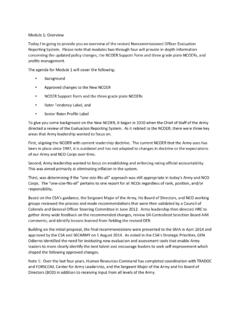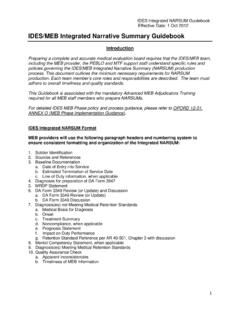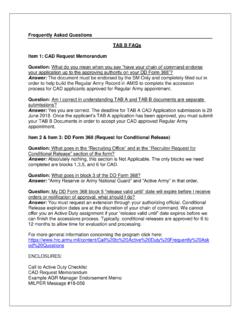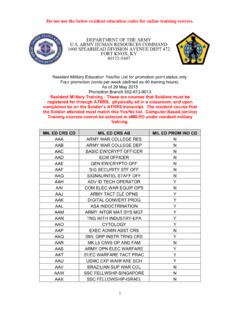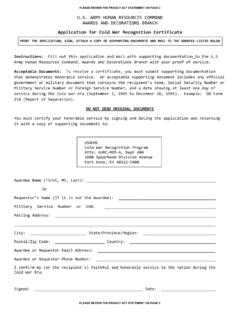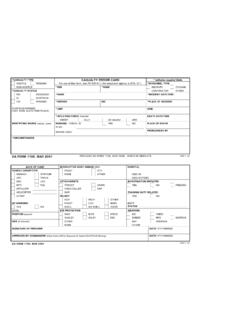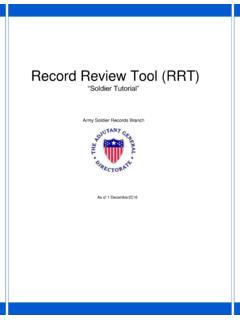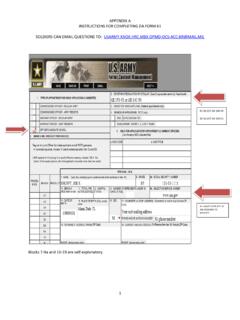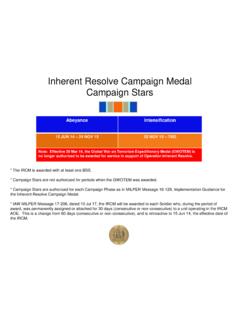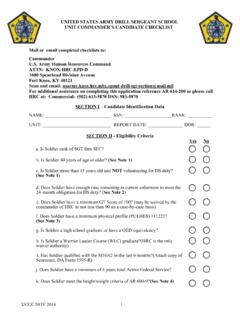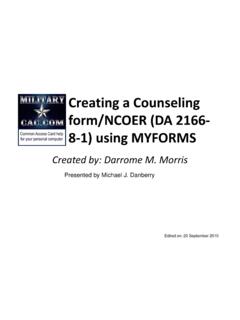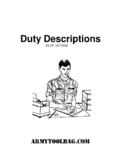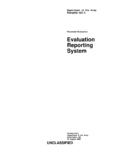Transcription of Module 3: NCOER Support Form & Grade Plate NCOERs
1 Module 3: NCOER Support form & Grade Plate NCOERs During this block of instruction, I will provide detailed information on the DA form 2166-9 series, which includes the NCOER Support form and the three Grade Plate NCOERs . I will cover the key form changes, as well as provide clarification for the definitions and descriptions for the leader attributes and competencies and Rater and Senior Rater box scale. If you have questions during the brief, please feel free to ask them. Here s the agenda and the following key areas I will discuss: What is changing on the NCOER DA form 2166-9 Series and the parts of each form Leader Attributes and Competencies Performance Measures In addition, I ll also discuss the rater and senior rater assessments for each form and the senior rater potential measures. Here is a comparison chart of the current NCOER and the New NCOER .
2 As you can see, the New NCOER Support form aligns with current doctrine, ADP 6-22; whereas the current NCOER is based on outdated doctrine. The DA 2166-9 now has an entry for the rated NCO to provide their goals and expectations for that rating period. The Support form also incorporates an SSD/NCOES completion box for the next Grade so that the rater and senior rater may track the progress of the NCO s Military Education Level and attaining promotion eligibility. Three reports were developed for the levels of leadership, based on Grade and scope of responsibility. The first NCOER form , which is referred to as the direct-level report is for NCOs in the rank of SGT. This form is developmental in nature. At this level, junior NCOs are refining the ability to apply competencies at a proficient level. The organizational-level form is for SSG through MSG; it focuses on organizational systems and processes.
3 In this level of leadership, NCOs apply competencies to increasingly complex situations. The last form is the strategic-level report for CSM/SGM. At the strategic level, leaders shape the military through change over extended time. There is a clear delineation between the rater and senior rater responsibilities. The rater will assess performance only and the senior rater will assess potential. The senior rater will also assume the role/responsibility of reviewer. The role of supplementary reviewer has been added and there are certain cases when a supplementary review is required. The assessment format has also changed as the senior rater comments will be written in narrative format and the entire assessment for CSM/SGM will be written in narrative comments. The new NCOER is designed to reduce inflation and this will be accomplished through the controlled potential-based senior rater assessment and also by incorporating a rater tendency label and a managed senior rater profile for SSG through CSM/SGM.
4 As mentioned on the previous slide, DA form 2166-9-1A, the NCOER Support form , will align with Army leadership doctrine. In addition, the rated NCO s current Military Education Level (MEL) and Structured Self Development (SSD) codes will be included on the form . This will enable the rating officials to mentor and counsel the rated NCO and track his/her progress in attaining promotion eligibility for the next Grade . In the case of Sergeants Major, eligibility for joint and/or nominative assignments. Another key change is the ability for the senior rater to counsel the rated NCO twice during the rating period and document it on the NCOER Support form . This will complement the rater s initial and quarterly counseling session. Also, with the implementation of a senior rater profile, it becomes more critical for the senior rater to provide counsel and mentorship to the rated NCO.
5 In Part IV, the rated NCO will list their goals and expectations. This change gives the rated NCO input about goals and expectations but will also place more onus or responsibility on the rated NCO to perform throughout the rating period. The information provided gives the rating officials additional information to consider when evaluating overall performance and potential at the end of the rating period. As mentioned, the NCOER Support form does capture the attributes and competencies from ADP 6-22. In Part V, in the left column, the rater will identify the major performance objectives based on the attributes and competencies listed in ADP 6-22. In the right column, the rater can list the rated NCO s contributions or accomplishments these comments can help provide the basis for the NCOER itself. In Part VI, the senior rater will be able to provide comments based on counseling sessions conducted with the rated NCO.
6 The next several slides are screenshots of the draft Grade Plate NCOERs , broken down by section. As for the front page, it is the same for all three forms with the exception of the DA form 2166-9-3 (CSM/SGM), which will be written in narrative comments. In Support of the Department of Defense s initiative to discontinue the use of Social Security Numbers, the 10-digit DOD ID Number (located on the back of the Common Access Card (CAC)) will be utilized versus the rated NCO s SSN. Rated NCOs, rating officials, and delegates must ensure that UICs are entered correctly in Part I, block h. If the UIC is entered incorrectly, the reporting database, Evaluation Reporting System (ERS), will not be able to retrieve information for that invalid UIC. Like IWRS, ERS is the status reporting database for all evaluations processed in the Evaluation Entry System (EES). During a rated Soldier lookup, if the UIC is incorrect, then contact your unit S1 to update the database of record (usually EMILPO).
7 You can overwrite the information on the NCOER , however, it will not correct the main database. Remember if you use the NCOER Support form in the online system, all of the admin information entered on the form will auto-populate the NCOER when it is created from the Support form . (This is key to data accuracy in the Evaluation System process.) DOD ID Numbers will be utilized for rating officials as well. If DOD ID Numbers are not available, then the SSN will be used. An example of this is when a rating official does not have a DOD-issued CAC ( , rating officials who work for the State Department and Congress.) AKO email addresses will not be entered on the form , use DOT GOV or DOT MIL. As mentioned before, the senior rater will be perform the review unless a supplementary review is needed. If a supplementary review is not required, then the user will select NO in Part II, block c1 and leave the remaining section blank.
8 If the Uniformed Army Advisor determines comments are necessary, he or she will select YES in Part II, block c4 of the NCOER and prepare an enclosure to the NCOER which will address the accuracy and clarity of the completed NCOER . Note: The comments will not include evaluative statements about the rated NCO or statements that amplify, paraphrase, or endorse the ratings of the other members of the rating chain. The rated NCO s signature will verify the accuracy of the administrative data in Part I, confirming the name and SSN on the evaluation report, rank and date of rank, branch or MOS data, period covered and nonrated time; the rating officials and counseling dates in Part II; the duty description in Part III, and the APFT and height and weight entries in Part IV. This procedure ensures that the rated NCO has seen the completed evaluation report. It also increases the administrative accuracy of the evaluation report and will normally preclude an appeal by the Rated NCO based on inaccurate administrative data.
9 Remember if you use the NCOER Support form in the online system, all of the admin information entered will auto-populate the NCOER when it is created from the Support form . The duty description is comprised of five sections in Part III: The first section, Part III, block a, is the principal duty title. The duty title will parallel the duty title shown on the NCOER Support form . The next section, Part III, block b, is the duty MOSC. The duty military occupational specialty code (MOSC) (at least five characters but no more than nine) that coincides with the duty title will be entered. In cases where the rated NCO is filling an officer position, enter the enlisted MOSC that best matches the officer position. The third section, Part III, block c, is a description of the daily duties and scope the user will enter the most important routine duties and responsibilities.
10 Unless changes occurred during the rating period, the duty description on the NCOER should be the same as the one on the NCOER Support form . (Note: Written in a series of phrases, starting with action words, separated by semicolons, and ending in a period. Use present tense.) The fourth section, Part III, block d, areas of special emphasis, is a list of tasks or duties that required top priority during the rating period such as SRP, UPL, or Master Resiliency. (Note: Separated by semicolons and ending in a period.) The last section, Part III, block e, is the list of appointed duties. These are duties appointed to the NCO not normally included in the duty description. (Note: Separated by semicolons and ending in a period.) Remember, if you complete the NCOER Support form within EES, then all of the admin information will auto-populate the NCOER when it is created.
